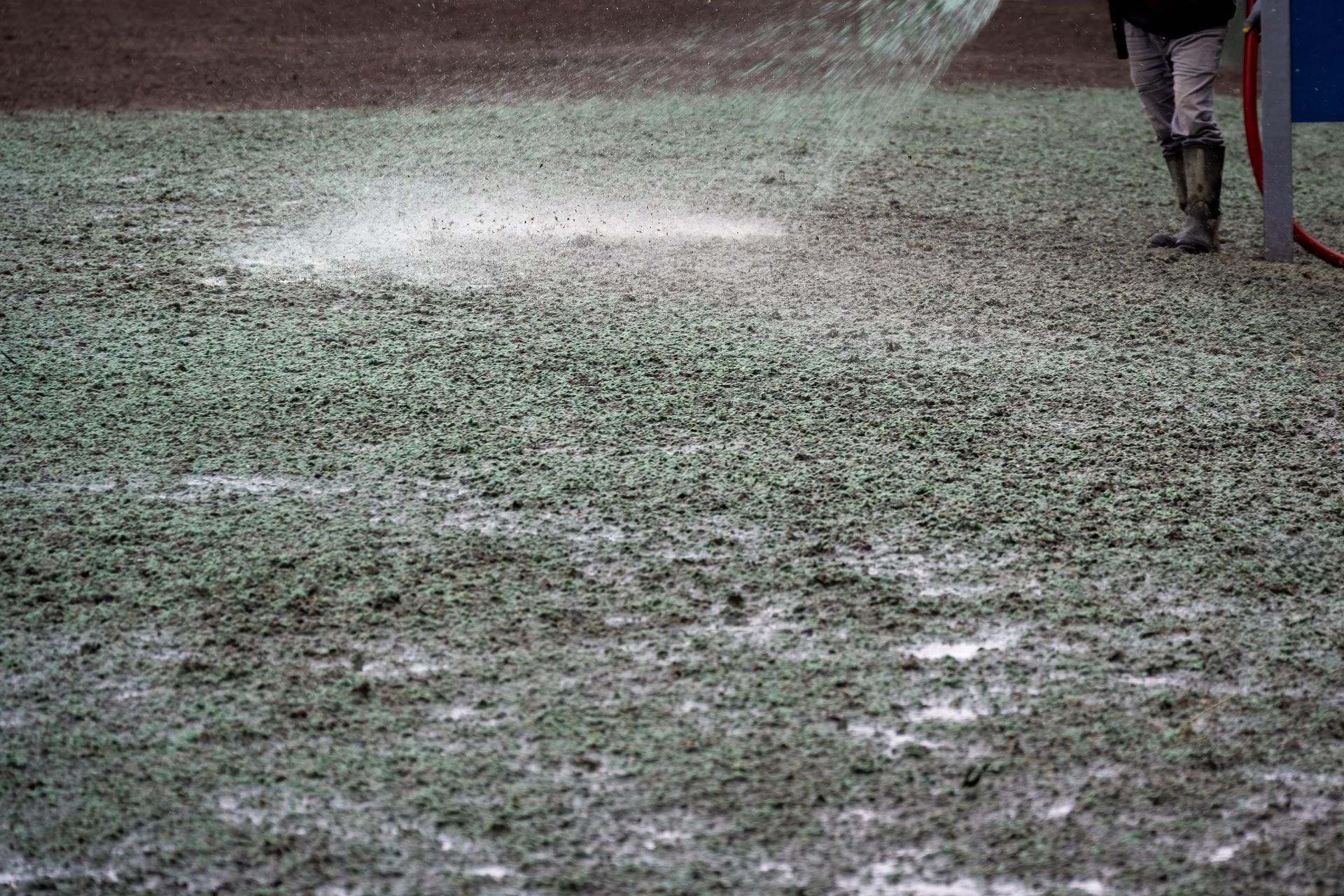Construction activity and land clearing can leave soil liable to erosion and sedimentation, which eventually mixes with stormwater runoff and leads to pollution.
Experts often recommend temporary seeding, especially on hills and slopes, to improve soil infiltration and slow the velocity of stormwater runoff. While many temporary seeding solutions exist, we’d like to discuss the best one of them all, which is hydroseeding.
Faster acting than mulch, hydroseeding can be the perfect way to stabilize slopes and native vegetation during residential and commercial construction projects that require quick and effective solutions.
What Is Hydroseeding?
Hydroseeding, also known as hydraulic mulch seeding, is a planting process that involves spraying a slurry of seeds, mulch, water, tackifiers, and other additives onto the soil. This slurry acts quickly, establishing roots and promoting fast vegetative growth that can help protect bare or eroded soil.
Hydroseeding is primarily used to establish grass and wildflowers but can be used for other vegetation, depending on the slurry.
The hydroseeding slurry requires a special tank and sprayer that enables it to be spread evenly and over large surface areas. In this sense, it is often easier to set down than mulch or erosion control blankets if you need to cover a large area of soil.
Key Components of the Hydroseeding Mixture
To understand why hydroseeding is so powerful and effective, it’s important to understand how each ingredient in the slurry works together to promote growth.
- Seeds: Depending on the desired vegetation, different types of seeds can be used, such as grass, wildflowers, or ground cover.
- Mulch: Often made of wood fibers, paper, or a combination, the mulch retains moisture, provides insulation, and protects seeds.
- Water: Essential for mixing the slurry and hydrating the seeds.
- Fertilizer: Provides nutrients to enhance seed germination and plant growth.
- Tackifiers: Additives that help the slurry adhere to the soil, preventing erosion and seed washout, especially on slopes.
Benefits of Hydroseeding
Hydroseeding offers several benefits compared to traditional seeding methods, such as broadcasting or sodding:
1. Cost-Effectiveness
Hydroseeding is significantly more cost-effective than sodding, particularly for large areas. As previously stated, hydroseeds can be spread over a large area using a single tank and laborer.
While sod installation involves high labor costs and expensive materials, hydroseeding requires less manual labor and uses fewer materials, making it a budget-friendly option. For large-scale projects, there is no more efficient alternative to hydroseeding.
2. Faster Germination and Growth
The slurry mixture used in hydroseeding helps accelerate seed germination, allowing seeds to become established within 3-4 weeks.
3. Superior Erosion Control
Hydroseeding is not only fast-acting, but the slurry mixture actually helps prevent erosion while the seeds germinate. For example, the mulch acts as a protective layer, shielding seeds from wind, water runoff, and soil erosion, while the tackifiers prevent the slurry from being washed away due to runoff.
4. Improved Seed-to-Soil Contact
The hydroseeding process ensures that seeds have direct contact with the soil, a critical factor for successful germination. The slurry mix is evenly distributed over the soil surface, ensuring uniform coverage and eliminating the patchiness that often occurs with traditional seeding methods.
5. Customizable and Versatile
Hydroseeding is highly customizable, allowing for the creation of specialized seed blends tailored to specific site conditions, such as soil type, sunlight exposure, and local climate.
6. Enhanced Aesthetic Appeal
Hydroseeding can produce a lush, dense, and uniform lawn or vegetation cover that is uniform and visually appealing. As stated, hydroseeding guarantees fewer bare spots and results in much thicker grass.
7. Environmentally Friendly
All materials inside the slurry are biodegradable and environmentally friendly. Hydroseeding reduces the need for chemical herbicides and pesticides, as the thick mulch layer helps suppress weed growth naturally. Additionally, because it promotes rapid vegetative growth, hydroseeding helps to sequester carbon and improve air quality.
Applications of Hydroseeding
While hydroseeding is most commonly used in commercial projects, it can be used for a variety of purposes, including:
- Residential Lawns: Quickly establish a healthy, green lawn at a fraction of the cost of sod.
- Commercial Landscapes: Beautify large commercial properties, parks, and recreational areas, while also reducing the risk of erosion
- Erosion Control: Stabilize soil on slopes, embankments, and construction sites to prevent erosion.
- Revegetation Projects: Restore vegetation in areas affected by wildfire, mining, or other disturbances.
- Roadside Planting: Green highway medians and roadside areas efficiently.
Hydroseeding is a fast-acting and reliable solution to temporary and permanent seeding. Be sure to trust your hydroseeding needs with a qualified environmental management company.
FAQs
How long does it take for hydroseeding to grow?
Germination typically begins within 7 to 10 days, depending on the seed type, weather, and soil conditions. Full growth may take a few weeks to a few months.
What kind of maintenance does hydroseeding area require?
Initially, frequent watering is necessary to keep the mulch moist and promote germination. Once established, the maintenance requirements are similar to other lawns, including mowing, fertilizing, and watering.
Can I hydroseed in any season?
Hydroseeding is most effective in spring and fall when temperatures are moderate and there is adequate rainfall. However, it can be done in other seasons with proper irrigation.

